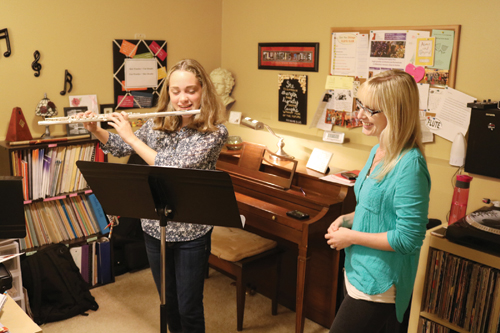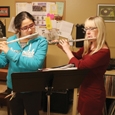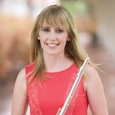
Sightreading is one of the most important skills for a musician to have, but it can be a point of frustration and anxiety as well. During my own musical training, I did not feel comfortable with my sightreading skills until graduate school. As a result, I make developing sightreading skills early on a part of the curriculum for my studio. Once students attain a level of comfort with sightreading, it can be incredibly valuable and a helpful tool.
Start Early
Students should sightread as soon as there is a clear understanding of note-names, basic time signatures, key signatures, and standard rhythms. This can occur as early as the first weeks of study. Students are often afraid of sightreading after being required to sightread for a grade in school. Many students have received no instruction about how to sightread, so they are unsuccessful and shudder when the topic is mentioned. Early introduction to sightreading and frequent exposure to the skill make it just a normal part of playing.
First Steps
Define sightreading for students. It means to read and perform music at sight. Explain that good sightreading skills help musicians become strong, members of an ensemble, succeed in auditions, and save time with Smart Music and other assignments. Many auditions offer only 30 seconds to look over the music. Teach students how to use this time wisely. For sightreading material, select music that is appropriate for the student’s ability level. Since sightreading is the ultimate multi-tasking test, teach the following steps focusing at first on 1-4. Then as a student’s skill level improves (especially with pulse and rhythm), add the rest.
1. Check the time signature, the key signature, and the tempo marking(s).
2. Based on the tempo marking, select a pulse. The pulse is often determined by the fastest note values in the piece. Clap the chosen pulse (or internally think it).
3. Take a moment and think through or clap each type of sub-division. Look for any unusual rhythms in the piece and mentally place them with the pulse, figuring out where the main beats are.
4. Find accidentals and familiar note patterns such as scales and arpeggios.
5. Check articulation marks.
6. Check the dynamics and observe them when playing.
7. Find the ornaments and think through how to play them within the rhythm.
8. Sightread the piece.
Assessing the Performance
Discuss what went well so students see progress and do not get discouraged. Reflect on what the student could have looked at more carefully during the 30-second preparation. Usually beginners struggle with rhythm. With problem passages, analyze how the passage should be counted and practice clapping it before trying again. With advanced students, discuss how they may challenge themselves by taking a quicker tempo, playing more confidently, and observing all dynamics and articulation marks.
Sightreading Duets
Sightreading duets develops the skill to keep going after making an error. Musicians like to fix every mistake. Sightreading teaches the art of letting go of mistakes for the greater goal of reaching the end of the piece. Duets are a fun to way to practice this concept. Students get excited about the beautiful harmonies they create and enjoy the process. Use the same 30 second preparation with the eight steps before starting to play.
For beginners, playing with someone who has a different part from their own can be overwhelming. I usually select a small section of the duet to work on, typically a couple of lines. Have students play their parts alone first. Sometimes I play their part with them. Then I play the second part while they follow along on their part with their eyes or a finger. Point out measures where the two parts play the same or different rhythms. After gaining familiarity with the music, we play together. Technically at this point it is not sightreading, but typically after playing a few duets using this process, students have the confidence to sightread duets.
When playing any ensemble music, it is important for all parts to begin together. Have beginners practice counting off the piece using the tempo they have selected. Then practice starting with a breath that is in the tempo of the duet.
As students gain skills, I tell them that I am going on no matter what. It is their job to move through mistakes and get back together as quickly as possible. When the piece is over, I emphasize how well they did this as well as discussing that mistakes are bound to happen in sightreading, and it is the recovery that matters the most. Point out spots that have tricky note patterns or rhythms, and over time students will become better at finding these spots during the initial preparation.
In preparation for sightreading work, give students a list of common tempo markings to learn. When selecting sightreading material, expose students to music from a variety of style periods. Use repertoire with different time and key signatures as well as different tempos.
For advanced sightreaders, use duets that have two separate parts where you cannot see the other person’s music. Canonic duets are also an option for players who need a challenge.
Favorite Sightreading Materials
For solo repertoire I use various solo collections and etude books depending on each student’s level. For duet playing I have a list of favorite books that I often use in my studio.
6 Canonic Sonatas for Two Flutes, G.P. Telemann
Album of Flute Duets, Louis Moyse
Classic Christmas Carols for Band: Flute, David Newell
Learn to Play Flute Duets Book One, William Eisenhauer
Rubank Method Book Series, H. Voxman
Selected Duets for Flute Volume I and II, H. Voxman
The Many Moods of Christmas Book One, Ricky Lombardo
Practice Sightreading Often
Sightreading is a skill that must be taught and practiced on a regular basis. This helps students assess progress and develop a comfort with the process. Especially when preparing for an audition, I encourage students to practice sightreading at home using repertoire they have not played in flute books or by finding new music online. With continual guidance and practice, players can see amazing improvement, and it no longer must be a fearful part of their musical lives.






